During my first semester at Pacific School of Religion, I took a class titled: Sexuality and Spirituality. This final paper for this class focuses on and compares the historical use of pain by the religious to gain a deeper connection to the divine with the modern uses of pain as a spiritual practice. There is a link at the bottom of this post in PDF format.
Daniel Borysewicz © 2014
 The connection of spirituality and pain has a long history within some faith traditions and cultures. ‘Mortification of the flesh’ is a term used by Christians that pertains to ways of atonement and repentance. Self flagellation was very common in this practice. While the intended purpose was to cause pain to atone for pleasures of the flesh, within the bondage, domination, and sadomasochist (BDSM) world, this pain can be used for achieving a higher level of consciousness and even trance-like states. This does not only pertain to the utilization of pain but also the use of domination and submission in attempting to attain a more spiritual connection to the Divine.
The connection of spirituality and pain has a long history within some faith traditions and cultures. ‘Mortification of the flesh’ is a term used by Christians that pertains to ways of atonement and repentance. Self flagellation was very common in this practice. While the intended purpose was to cause pain to atone for pleasures of the flesh, within the bondage, domination, and sadomasochist (BDSM) world, this pain can be used for achieving a higher level of consciousness and even trance-like states. This does not only pertain to the utilization of pain but also the use of domination and submission in attempting to attain a more spiritual connection to the Divine.
I will be exploring some of the history of BDSM-like practices within Christianity. Through this analysis, I will provide some correlation between the present day practitioners of BDSM and the practices of the past. Many today think that those who participate in BDSM practices are perverted deviants and are only interested in it for the sexual gratification. While this may be true for some, there are many others attempting to achieve their own connection to a spirituality that is no different than what many people of faith are attempting to connect to while in their places of worship.
Before we get started, let us review some terminology surrounding BDSM. Bondage can have several meanings: to be a serf or slave; to be bound by compulsion to something, like drugs; or practices involving the physical restraint of one partner.[1] Domination has to do with control over another human. As Merriam-Webster puts it: “supremacy or preeminence over another” (Merriam-Webster 2009). The typical name for a dominant person is ‘Dom’ or ‘Top’. A person who would look to be dominated is typically called a submissive. A ‘submissive’ can be called a ‘slave’ or just ‘sub’ for short and they enjoy being dominated by others. A ‘slave’ is not bought but commits freely to this way of life.
Sadomasochist can actually be broken into two parts: Sadist and Masochist. A sadist is someone who gets pleasure from inflicting physical or mental pain upon another. And a masochist is someone who gets pleasure from being abused or dominated. It should be noted that according to Merriam-Webster, both of these characteristics are considered to be “a sexual perversion” (Merriam-Webster 2009).
Why Pain?
Let us first look at some of the details about pain. It is typically a good indicator that if something is wrong with part of our body. It could be a headache due to stress, lack of coffee or caused by a deeper lying health issue. Pain can also help determine if someone injured themselves and there are no visible signs of injury on the body. Minute amounts of pain can be annoying and easily dealt with by taking some ibuprofen or Advil. Certain levels of pain possess a certain analgesic quality, according to neurologists, and can even induce states of euphoria (Glucklich 2001, 30).
 Pain also has a quality that can be incorporated into the body and this depends on whether the pain is voluntary or involuntary. What this means is that if you cut your finger while chopping vegetables, the reaction is to wince away from the knife and the pain is typically considered negative. This is considered ‘involuntary pain.’ An example of ‘voluntary pain’ is when a young man or woman takes a razor blade and cuts the insides of their thighs. This is typically done to induce pain to relieve another pain – one that can be an emotion pain or stress related (Glucklich 2001, 79). In the book Sacred Pain: Hurting the Body for the Sake of the Soul by Ariel Glucklich, there is great detail about the various descriptions and models of pain. It is not my intention to outline those here but to note that the models of Magical, Shared and Ecstatic pain, that Glucklich mentions, contain the properties that pertain to this paper (16).
Pain also has a quality that can be incorporated into the body and this depends on whether the pain is voluntary or involuntary. What this means is that if you cut your finger while chopping vegetables, the reaction is to wince away from the knife and the pain is typically considered negative. This is considered ‘involuntary pain.’ An example of ‘voluntary pain’ is when a young man or woman takes a razor blade and cuts the insides of their thighs. This is typically done to induce pain to relieve another pain – one that can be an emotion pain or stress related (Glucklich 2001, 79). In the book Sacred Pain: Hurting the Body for the Sake of the Soul by Ariel Glucklich, there is great detail about the various descriptions and models of pain. It is not my intention to outline those here but to note that the models of Magical, Shared and Ecstatic pain, that Glucklich mentions, contain the properties that pertain to this paper (16).
Pain has a unique quality for humans on how it affects the body. Some believe that it can help to transform the person, while others look at it from a perspective of a shared experience. ‘I feel your pain.’ How many times have we heard or said this to empathize with someone who was suffering? To truly feel one’s pain is to have experienced a similar or exact pain or suffering beforehand. Others look to create temporary states of euphoria though the use of pain. Glucklich discusses practitioner of this model:
A particularly revealing contemporary manifestation of this model can be seen in the rituals and discourse of a man who calls himself Fakir Musafar and publishes the journal Body Play. Fakir is a leading player in a subculture that centers on body modifications: piercings, tattooing, and a variety of so-called modern primitive rituals. He has subjected himself to an eclectic assortment of mutilations, modifications, and tortures gathered from several sources, including Indian Sadhus, American Plains Indians, Christian ascetics, Sufi mystics, and others. (Glucklich 2001, 31)
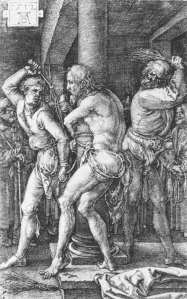 It is important to understand that the effect of pain on the human body has to do with biochemistry. Our bodies will release certain chemicals to compensate or combat an injury or pain. When I sprained my hand once in a sporting accident, my hand swelled to almost three times its normal size. My body was creating a cast of sorts to protect the injury. As I mentioned above, certain levels of pain can initiate euphoric states for a person, like Fakir Musafar, who is voluntarily inflicting pain to themselves. Use of pain in this fashion is considered a tool by many.
It is important to understand that the effect of pain on the human body has to do with biochemistry. Our bodies will release certain chemicals to compensate or combat an injury or pain. When I sprained my hand once in a sporting accident, my hand swelled to almost three times its normal size. My body was creating a cast of sorts to protect the injury. As I mentioned above, certain levels of pain can initiate euphoric states for a person, like Fakir Musafar, who is voluntarily inflicting pain to themselves. Use of pain in this fashion is considered a tool by many.
As a tool, pain has been used by many over the centuries. It was typically used for torture, to compel the ‘guilty’ to confess their sins or crimes. It was a familiar theme for medieval monastic treaties and vitae that I will discuss later (Mowbray 2009, 73). The discomfort to the human body caused by pain, at various levels of intensity, was utilized as a distraction from the pleasure of the body and as a means of penance to atone for sins committed. From this pain, the idea of suffering is what religious people grasp onto to move closer to God. In 1984, Pope John Paul II stated:
[T]he joy comes from the discovery of the meaning of suffering…what we express with the word ‘suffering’ seem particularly essential to the nature of man…suffering seems to belong to man’s transcendence. (Glucklich 2001, 4)
It is this transcendence through pain and suffering that Christians can equate to the life of Jesus, in that He had to suffer before ascending to His Glory (Jones, Wainwright and Yarnold 1986, 14).
Some tools have but one purpose. But in the case of pain, it has numerous purposes and uses. As I will describe below, pain can be used as a means towards atonement, as a means to emulate the suffering of Jesus, as a means to grow emotionally and spiritually and as a “restorative power” (Mowbray 2009, 61). All of these I have stated thus far specifically point towards religious praxis. These same notions of ‘tools’ are also being utilized by those living or engaging in a BDSM lifestyle. These are also used to teach and recondition the individual by inducing an altered state to affect a change in learned patterns. Some of the best ways of learning is through suffering. Exposure to acute pain can allow the person to pass through to the other side with lasting effects that cause permanent change to the self (Thompson 1991, 279)
Early Practices of Mortification of the Flesh
Why use pain to connect with God? Humans are made of flesh with a soul. Many believed that for the soul to truly connect with God, the pleasures and sins of the body must be overcome to ready to be received by God. In medieval monastic life, the enchiridions of the time were rather clear on the importance of the amount of pain monks were expected to self impose:
Brother, it is necessary for thee to be punished in this life or in purgatory: but incomparably more severe will be the penalty of purgatory than any in this life. Behold, thy soul is in thy hands. Choose therefore for thyself whether to be sufficiently punished in this life according to canonical or authentic penance, or to await purgatory. (Glucklich 2001, 60)
The message is quite clear; suffer in this life to ensure less suffering after death. There are documented cases regarding religious figures that regularly practiced self mortification of the flesh.
 Those who wished to live an ascetic life, were among those who submitted themselves to pain and suffering through “repeated genuflections, immersions in cold water, the wearing of hairshirts and flagellation” (Mowbray 2009, 73). They believed that these practices would help them to renounce the world of the flesh and all of its desires and yearnings. As Glucklich states, this is a form of ‘Sacred Pain.’ The need and desire of religiously motivated individuals and institutions to transmute pain into purposeful theological trials actually takes place not on a normal level of consciousness but on a unconscious level that is not necessarily intentional by the individual (Glucklich 2001, 78).
Those who wished to live an ascetic life, were among those who submitted themselves to pain and suffering through “repeated genuflections, immersions in cold water, the wearing of hairshirts and flagellation” (Mowbray 2009, 73). They believed that these practices would help them to renounce the world of the flesh and all of its desires and yearnings. As Glucklich states, this is a form of ‘Sacred Pain.’ The need and desire of religiously motivated individuals and institutions to transmute pain into purposeful theological trials actually takes place not on a normal level of consciousness but on a unconscious level that is not necessarily intentional by the individual (Glucklich 2001, 78).
The use of pain and suffering to connect with the Divine was gleaned from the emerging vocabulary surrounding the interactions of humans and Christ. The masters[2] synthesized this vocabulary into a theological framework for laypersons to understand and support the ideas around suffering and pain (Mowbray 2009, 41). To be ‘Christ-like’ you need to emulate the suffering and pain that Jesus went through near the end of His life. To achieve His Glory, as mentioned above, He was to suffer here on Earth, so should the Christian suffer to achieve their glory when they die. It is interesting to note that this does not appear to adhere to the notion of reparations for sinning. Jesus did not suffer due to sin. Perhaps, because humans are not the ‘Son of God’ they are sinful and must repent for the sins of the mind and flesh. It is important when examining the religious use of suffering to look to the source of Christian teaching, the Bible.
When exploring the practices of a culture or institution, it is important to examine doctrine and the written word on said practices. As I am finding during my time at seminary, scripture can be used to examine current day situations and also to lift up reasons for acceptable practices. The masters that I mention above had the same scriptures to help define the vocabulary regarding the importance of suffering as a Christian. Here I will look at a few passages from the Bible (NRSV Bible 1989) and provide potential evidence to confirm my speculation that the masters used the scriptures to encourage pain and suffering for their devotees.
Proverbs 20:
30 Blows that wound cleanse away evil;
beatings make clean the innermost parts.
The literal interpretation of this passage is that being struck hard enough to inflict injury will wash away sins and purify one’s soul. This passage could be lifted up to justify the wounds created by the practices of mortification of the flesh, like flagellation and use of a cilice. Freud believed that the use of pain was to remove feelings of guilt:
Voluntary pain is a form of self punishment that subdues guilty inner voices by suppressing the effects of instinctual drives, especially sex, which conflict with broader social constraints. (Glucklich 2001, 85)
Religious leaders, especially Catholic priests and nuns were expected to live a life of celibacy. The instinctual sex drives of humans do vary from person to person. However, to be of pure mind, body, and soul to commune with God, these desires would sometimes need to be driven away by pain. We will look at some examples of this later.
1 Peter 4:
1 Since therefore Christ suffered in the flesh, arm yourselves also with the same intention (for whoever has suffered in the flesh has finished with sin).
This passage provides a directive for the reader. To be ‘Christ-like’ you must suffer as Jesus did. By this the sufferer will have their sins removed. Freedom from sin was achieved through suffering of the flesh. As with Christ, the Christian’s soul suffers by means of the suffering of the flesh (Mowbray 2009, 18). It is the soul that needs to suffer to be free of sin.
Colossians 1:
24 I am now rejoicing in my sufferings for your sake, and in my flesh I am completing what is lacking in Christ’s afflictions for the sake of his body, that is, the church.
Here Paul is rejoicing in his suffering. This suffering is not specified to be either of the flesh or soul but is for the church none the less. His rejoicing could be equated to accepting his own suffering and that makes him a better Christian. He was imprisoned at the time of writing this letter and this would explain a dimension of his suffering (O’Brien 1982, 75). Acceptance of one’s suffering will make them a better Christian? This is another example of how the lifting up of pain and suffering has been utilized by the Christian churches over the centuries.
The greatest example Christians regarding pain and suffering for their faith is Jesus. Since His crucifixion, there have been many saints and laypeople who have emulated Christ’s suffering to proclaim their devotion to God and their faith in Christianity. It is important to note that these acts of mortification were for a higher goal or telos and a sacrifice was required of the individual, as Jesus did (Glucklich 2001, 98). Jesus made the ultimate sacrifice by giving up his life for his beliefs. The pain and suffering that is desired by early Christians was not always to that extreme. To live and suffer as Christ is the message (Warrington 2009, 16).
 Maria Maddalena de’ Pazzi was one such person who embraced pain and suffering to emulate Jesus and to be closer to God. She was from Florence, Italy and lived in the late 1500s. Throughout her life, she submitted herself to various forms of torture. She added nails to a corset so they would pierce her skin when she wore it. Maria would wear a crown of thorns to bed at night to embody the torment that Jesus must have endured when his crown. When she was not emulating Jesus, she used self-inflicted pain to battle the desire of the flesh regarding gluttony or lust. Through Jesuit training that began when she was a child, she became a nun in 1583. Sister Maddalena’s practices were known by many when she entered into the monastery:
Maria Maddalena de’ Pazzi was one such person who embraced pain and suffering to emulate Jesus and to be closer to God. She was from Florence, Italy and lived in the late 1500s. Throughout her life, she submitted herself to various forms of torture. She added nails to a corset so they would pierce her skin when she wore it. Maria would wear a crown of thorns to bed at night to embody the torment that Jesus must have endured when his crown. When she was not emulating Jesus, she used self-inflicted pain to battle the desire of the flesh regarding gluttony or lust. Through Jesuit training that began when she was a child, she became a nun in 1583. Sister Maddalena’s practices were known by many when she entered into the monastery:
Maria Maddelena’s self tortures are not only vivid illustrations of sanctioned “masochism.” They provide an unusually detailed map of the subjective experiences of the religious self-hurter. The details put to easy rest any notion that pain is a monolithic experience lacking subtlety, ambiguities, or inner contradictions. It is possible, based on information obtained from Maria’s confessors, superiors, and sisters, to distinguish at least three major types of pain in her monastic life: voluntary self-inflicted pain, pain she felt inflicted on her by devils and which may have be nonconscious forms of self-mutilation, and natural pain (disease). (Glucklich 2001, 82)
It is through Saint Maria Maddalena de’ Pazzi’s mysticism that she is remembered. Through her letters to the Pope, bishops and priest towards the end of her life did many of her visions and visitations by God become documented to be eventually translated for the world to read (Maggi 2000, 7).
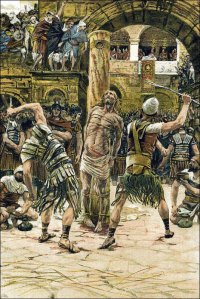 As previously mentioned, the prescribed life of the monastery involved self-inflicted pain and suffering. The text Regula Magistri (Rule of the Master[3]) is one example of proscriptions to those living a monastic life. The Rule of St. Benedict is believed to use Regula Magistri as its basis. It is through these ecclesiastic texts that religious leaders propagated their doctrine regarding corporeal punishment for children, minor clerics, and monks. These texts also included other practices directing subjugates to imitate Christ’s sufferings (Glucklich 2001, 73).
As previously mentioned, the prescribed life of the monastery involved self-inflicted pain and suffering. The text Regula Magistri (Rule of the Master[3]) is one example of proscriptions to those living a monastic life. The Rule of St. Benedict is believed to use Regula Magistri as its basis. It is through these ecclesiastic texts that religious leaders propagated their doctrine regarding corporeal punishment for children, minor clerics, and monks. These texts also included other practices directing subjugates to imitate Christ’s sufferings (Glucklich 2001, 73).
The lived and written examples of the importance of pain and suffering as it pertains to the Christian seem very apparent. To be ‘Christ-like’ is to suffer of the flesh as Jesus did. This will ensure that your soul will suffer here during this life so you will not suffer in the next one. Some of the suffering is not as extreme as I have mentioned here. Fasting and giving up ‘guilty pleasures’ during Lent is an example of suffering and abstaining to be more ‘Christ-like’ without the use of pain. Rejoice in your suffering as Paul rejoiced in his.
Practices of BDSM in Modern Times
Is the pain practiced in the past so different than the pain generated of the practices of BDSM today? Now we will explore the manifestation of spirituality through pain today and reflect back upon what has been previously discussed. Ask any Christian; Jesus was human and divine, wasn’t he? To attempt to be ‘Christ-like’ is to attempt to connect with or become one with Divinity. This is something that many practitioners of BDSM are attempting to do today. Those who move in spiritual circles, such as Native American Indians, and Buddhist monks, have been exploring the connections between pain and Divinity for a long time (Wappler 2005 ).
 As mentioned in my opening paragraphs, Fakir Musafar is one of many individuals who have been exploring the practices of a wide range of religious and cultural people in regards to pain and the spiritual self. Another member of the Leather community, Joseph W. Bean, has an interesting definition for spirit and spirituality:
As mentioned in my opening paragraphs, Fakir Musafar is one of many individuals who have been exploring the practices of a wide range of religious and cultural people in regards to pain and the spiritual self. Another member of the Leather community, Joseph W. Bean, has an interesting definition for spirit and spirituality:
My own idea of the human spirit…Spirit is that impulse in a man which urges him to discover his nature, overcome his fate, and strive for what destiny offers but does not promise. Spirituality—indistinct from the finest sorts of psychology—is not a thing that comes naturally to a man as his whiskers or sexual orientation does, but it is a facet of human nature. By learning to act from human nature rather than fighting or abusing it, a man becomes a balanced creature. (Thompson 1991, 259)
As part of my signature on emails, I have a quote from Walt Whitman, “Whatever satisfies the soul is truth.” [4] The definition above by Bean resonates with this quote from Whitman, in regards to human nature and the impulses of the human spirit. It is this facet of human nature that causes humans like Musafar to become that balanced human by these practices, just as Saint Maria Maddalena’s attempted to find the grace of God through her self-inflicted torments.
Are the modern practitioners of BDSM only in it for sexual gratification and nothing more? These are comments that have come from not only the heterosexual mainstream community but also from within the gay and lesbian community as well. For many years, and even today, BDSM has been condemned by a substantial number of people, including gays and lesbians. The visibility of men and women in leather may have pushed away many gays and lesbians who sought acceptance by a mainstream community (Thompson 1991, xii). Prior to the sexologist of the late 1800s and early 1900s, BDSM practices were not reviled as they would eventually became. Licensed psychotherapist Dorothy Hayden explains:
It has only been in the last hundred years that masochism has been seen as a perversion. When the nineteenth-century psychiatrist Krafft-Ebing placed the term masochism under the rubric “General Pathology” in his famous book “Psychopathia Sexualis”, masochism began to get bad press. A few decades later, Freud wrote about masochism as a function of infantile sexuality, incomplete development, stunted growth, and childish irresponsibility. Since then, masochism has been irrevocably allocated to the ghetto of “perversion” and the clinical community has viewed it as a pathological aberration that must be cured. (Dorothy C. Hayden 2009)
Does this prognosis mean that the practices performed for centuries by those who sought a connection to the Divine were sick and needed to be cured? Krafft-Ebing would say yes but theologians like St. Francis of Assisi would say they were only attempting to connect to God through the suffering of Jesus Christ (Jones, Wainwright and Yarnold 1986, 303).  Suffice it to say, there are some people who engage in BDSM for purely sexual reasons and even some of them have rejected the idea that BDSM is anything other than a sexually good time. I do not believe that their point of view negates the beliefs and practices of modern day practitioners or those in the past.
Suffice it to say, there are some people who engage in BDSM for purely sexual reasons and even some of them have rejected the idea that BDSM is anything other than a sexually good time. I do not believe that their point of view negates the beliefs and practices of modern day practitioners or those in the past.
Until this point, I have neglected to discuss the ritualistic aspect of BDSM practices. This I believe provides a unique aspect that can separate a spiritual practice from a sexual act. As seen in the movie The Da Vinci Code, the albino villain Silas ritualistically takes off his clothes, prays to the crucifix in his room, switches his cilice from his left thigh to his right thigh, and then begins self-flagellation. While this scene was dramatically sensationalized to create effect for the audience, there was significant emphasis on ritual involved. There is ritual within BDSM scenes and activities. Sensuous Sadie provides a description of a collaring ceremony she witnessed:
Madame Saki’s collaring ceremony was only the second collaring ceremony I’ve ever attended. This one is more formal [than the first one I attended], just a training collar, but a commitment taken seriously. Madame Saki is dressed in red silk with a layer of black lace, a rose curved into her breast. Her submissive, Cole, showed off his body, tall and lithe in a leather harness…They exchanged roses and vows, and we stood in a circle, warmed by the light of leather-scented candles and a riot of flowers. We bless their union as they bless our community…So then what is this relationship? Madame Saki tells me it’s not about sex, not eros, not romantic love. She says it is more about the philos flavor of love, brotherly love. No, not about sex, but about a caretaking and teaching relationship. (Sadie 2003, 112-113)
This collaring ceremony illustrates that there is much more to BDSM than just grabbing a whip and start to inflict pain upon someone. Madame Saki takes her role very serious as a teacher and caretaker for her new slave. I wanted to impress to the reader that this has been more of the norm regarding the personal interactions I have had with my own interactions with the BDSM community.
The way a sadist lays out his or her implements is very ritualistic. There are special connections to certain individuals through a favorite flogger or specific paddle. There is a level of reverence for each of the nipple clamps that the sadist has that can be equal to the various implements of a religious practitioner. Some would believe that these statements are profaning the sacredness of holy relics. But I would submit that one form of ritual can be no greater than another if the intent behind both is genuine, respectful, and sacred for the individuals involved. In relation to human behavior, ritual is an “embodied knowing” that allows humans to create and normalize their world by developing patterns of meaning that the human body can absorb and digest (Sheldrake 2005, 546). There are even workshops about bring ritual into BDSM play. Here is a description of one such example:
Ritual, whether you are spiritual or not, can bring a new level to your experiences or play. Theoretically, ritual can be any series of actions you do habitually. However the ritual we will discuss are any actions that are done with intention and belief to reach a higher energy level. Why bring ritual into it? BDSM play, on various levels, generally wants to evoke atmosphere to enhance the emotion during the play. Ritual works in creating the proper “space” or atmosphere and intent. This, in turn, intensifies the “mood” of the play by the heightened level of energy created. (SWLC 2009)
How someone adds sugar and cream to their coffee or tea can be a ritual as well. Based on the Christian definition of ritual, the intricate knots used during a bondage scene can reflect a very sacred ritual for those who are performing it.
 Beyond the ritual part of BDSM, there is the aspect of administering and receiving pain. This is the crux of who the sadist is and who the masochist is. There needs to be a high level of trust and understanding between these two people before they engage in and BDSM play. For the novice masochist, they may be so desperate to find a sadist that they connect with the first one they meet. This can be a very dangerous situation for anyone, regardless of experience (Sadie 2003, 202). There are discussions that need to happen first. These are called ‘negotiations’ and they need to happen prior to anyone actually getting flogged or tied up.
Beyond the ritual part of BDSM, there is the aspect of administering and receiving pain. This is the crux of who the sadist is and who the masochist is. There needs to be a high level of trust and understanding between these two people before they engage in and BDSM play. For the novice masochist, they may be so desperate to find a sadist that they connect with the first one they meet. This can be a very dangerous situation for anyone, regardless of experience (Sadie 2003, 202). There are discussions that need to happen first. These are called ‘negotiations’ and they need to happen prior to anyone actually getting flogged or tied up.
This connection between the Dom and sub is very important. Too much of anything can be harmful to you. Whipping a sub to the point of unconsciousness is not the point of proper BDSM. Part of the spiritual euphoria that is being sought after comes from going just far enough but not too far. A sub explains:
With whipping you do a lot more fighting inside, pulling back, pushing yourself forward. When you start to peak, everything overwhelms and you crash into an incomparable state of peace. When I go through playing a role for a top, it forces me to take my life apart. I reconsider everything I’ve had to do. All the wonderful and lousy things I’ve thought. When I come out, I’m ready to rebuild and totally refreshed. (Mains 1984, 136)
Does this not sound like the transcendence that Pope John Paul II alludes to regarding the nature of man earlier in this paper? The pain inflicted upon his body allows him to connect to his soul and examine his life, the rights, and the wrongs and in the end is cleans of his past, renewed as if purified of his sins. The similarities between the use of mortifications of the flesh in the past and examples like this provide strong evidence regarding the spirituality of pain.
There are spiritual communities surrounding the use of BDSM. With the formation of the Metropolitan Community Church (MCC), there was a place for those who previously had no place to go to worship and not feel an outcast or be ridiculed. The people I am referring to are the Gay, Lesbian, Bisexual, and Transgender (GLBT) community. Within the BDSM community, sexual orientation or gender identity has typically not been an issue. Inclusiveness is something that many strive to achieve. One example of this kind of community is the Southwest Leather Conference, which is held in Phoenix, Arizona each year in January. The non-profit organization that manages this event has a very explicit mission statement:
Butchmanns, Inc. is a 501 (c) (3) non-profit national educational organization dedicated to self-actualization and the ending of suffering. Butchmanns facilitates and fosters spiritual growth and transformation by providing grants and educational opportunities to those often wrongfully stigmatized for their sexual expression, non-traditional relationships and/or unconventional spiritual practices. Butchmanns promotes the use of physical practices and the conscious exchange of personal power for spiritual awareness. We recognize all life-affirming spiritual paths as valid, affirm all mutually beneficial relationships as inherently sacred, and embrace adults of every age, race, body type, physical ability, sexual orientation, and gender identity. (SWLC 2009)
It is through events and organizations like these that provide a venue for community of likeminded people to come together to exchange ideas and connect on a spiritual level.
Another example of the connection between BDSM, spirituality, and religion is a social and educational group sponsored by MCC Los Angeles called People of Leather Among You (P.L.A.Y.).  The co-founder of this group is Pacific School of Religion alum Rev. Tim Hamilton. Here is an excerpt from his bio page on the MCCLA website:
The co-founder of this group is Pacific School of Religion alum Rev. Tim Hamilton. Here is an excerpt from his bio page on the MCCLA website:
Co-founder of MCCLA’s P.L.A.Y. group, along with Skip Chasey. People of Leather Among You was formed to support and encourage people to increase their awareness of radical sexuality and Spirituality in the same breath.
Founder of “Tribal Revival” a radically inclusive worship service at Southwest Leather Conference, where people from all walks of life are encouraged to bring their loving existence to worship – regardless of religious affiliation. (MCCLA 2009)
These are people who are not only embracing a religious and spiritual connection to Divinity through worship in the traditional sense but also through the ‘radical sexuality’ of BDSM. Protestant and Catholic reformers understood spiritual growth as including “both active choice and receptive surrender” and a modern look as spiritual growth points to embracing new ideas about faith and doubt which also requires the inclusion of science, social structures and religions from all over the world (Sheldrake 2005, 331).
From the earlier days when much of the BDSM community was deeper in the closet than the GLBT community to now where houses of worship are again recognizing the spiritual significant of individuals who wish to embrace various forms of pain to connect with Divinity, it is clear that the practices of BDSM are every bit as significant to spiritual growth today as they were during Saint Maria Maddalena’s time.
Conclusion
The spirituality of pain is a concept that many people would find difficult to comprehend. For many Christians, mention various saints that are well known to have practiced various sorts of ‘mortification of the flesh’ and they will be able to connect this pain and suffering with penance and atonement. 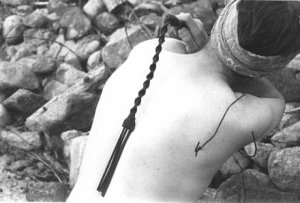 But as I have outlined above, moving through this penance and atonement is part of the spiritual growth than modern practitioners of BDSM are attempting to achieve. When speaking with someone who is a weightlifter, one of their famous catch phrases is: “No Pain, No Gain!” The gain is obvious for them, its muscle mass. The gain from the pain discussed above has to do with spiritual and personal growth.
But as I have outlined above, moving through this penance and atonement is part of the spiritual growth than modern practitioners of BDSM are attempting to achieve. When speaking with someone who is a weightlifter, one of their famous catch phrases is: “No Pain, No Gain!” The gain is obvious for them, its muscle mass. The gain from the pain discussed above has to do with spiritual and personal growth.
The pain and suffering here has been presented as a method of catharsis for the individual. I have clearly detailed the restorative power of pain in both modern and historical contexts. Denying the spiritual growth potential from pain is denying oneself of healing:
Sidestepping pain, by whatever method, never really succeeds. Though it may work for time in a man’s thinking, it fails to heal anything at the center of his life. (Lindell 1974, 22)
Through the evidence presented, pain has been described as a tool used by religious and spiritual people to achieve the aforementioned growth. For some, this pain and suffering will bring closer to their Christian God and Jesus Christ. For others it is more about an inward spiritual journey to atone for past digressions and to move forward free of guilt.
The vocabulary of early religious leaders has been outlined regarding doctrine about the importance of pain and suffering to be good Christian. These doctrines, like the Regula Magistri, encouraged followers to emulate Christ in His suffering so that they can be more like Him. Through the use of Biblical passages, I have lifted up specific examples of the importance of pain and suffering to connect with Divinity. The example of Saint Maria Maddalena and the discussion of Jesus I provided illustrate the very real connection that Christians in the past and today have with the utilization of pain to connect with Christ and God.
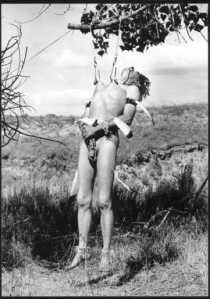 Through my comparison of Fakir Musafar and Saint Maria Maddalena, I provided a clear connection between past and present practices in regards to connecting to the divine and achieving spiritual growth. Musafar is famous for performing the flesh pull ritual of the Native American Indians that Richard Harris made famous in the movie A Man Called Horse. In the movie, it was only simulated but Musafar has done it many times in private and public (Thompson 1991, 304). Not only do some of these ritualistic practices of pain come from the religious beliefs of the West but also indigenous people as well.
Through my comparison of Fakir Musafar and Saint Maria Maddalena, I provided a clear connection between past and present practices in regards to connecting to the divine and achieving spiritual growth. Musafar is famous for performing the flesh pull ritual of the Native American Indians that Richard Harris made famous in the movie A Man Called Horse. In the movie, it was only simulated but Musafar has done it many times in private and public (Thompson 1991, 304). Not only do some of these ritualistic practices of pain come from the religious beliefs of the West but also indigenous people as well.
I would have been negligent to not include specifics regarding the discussions of sexologists regarding human behavior and sadomasochism. Human nature needs spirituality as a facet of itself, as previously discussed. The notion that Krafft-Ebing would diagnose the many Christian saints to be sick and needing to be cured would be absurd to many religious leaders in the past and today. Recall the definitions provided in the beginning? ‘Sexual perversion’ is what we have to thank the sexologists of the late 1800s for. Saint Maria Maddalena was not using it for sexual purposes.
The ritual aspect of BDSM has been presented and compared to religious practices in a way that should illuminate their similarities and not their differences. Ritual is essential to human behavior. When I was getting a latte this morning at a local coffee shop, I had to laugh at the way I make sure the crease on the cup is facing away from me before putting the lid on the cup. This is a ritual that I have been practicing for years. Included in the ritualistic practice is the need for trust and understanding between those who are engaging in BDSM play. This trust can allow the sub to be free of concerns and allow the pain to flow through them to achieve that ecstatic nexus with Divinity.
 The reemergence of a connection within the religious community and spiritual pain may be a surprise to some. The ministry work at MCC Los Angeles and the Southwest Leather Conference are just two examples of how a spiritual community has formed and grown around the practices of BDSM in a loving and caring way. I hope that through this discourse, I have eliminated the notion that people only practice BDSM for sexual gratification alone. As Madame Saki pointed out to Sensuous Sadie, the relationship with her new slave was not sexual at all – Philos, not Eros. These are words those in religious and spiritual circles understand very well. It is Divinity’s agape that many are seeking through BDSM.
The reemergence of a connection within the religious community and spiritual pain may be a surprise to some. The ministry work at MCC Los Angeles and the Southwest Leather Conference are just two examples of how a spiritual community has formed and grown around the practices of BDSM in a loving and caring way. I hope that through this discourse, I have eliminated the notion that people only practice BDSM for sexual gratification alone. As Madame Saki pointed out to Sensuous Sadie, the relationship with her new slave was not sexual at all – Philos, not Eros. These are words those in religious and spiritual circles understand very well. It is Divinity’s agape that many are seeking through BDSM.
It is my hope that I have provided the reader with sufficient evidence and discourse to reevaluate their previous opinion of BDSM and perhaps think less negatively of it in the future. For those who are more like minded with the people who practice BDSM today, it is my sincere hope that I have provided some new insights regarding the connections of the acts in the past by religious people and those being practiced today. To think otherwise would be unfortunate. Through the works of others and my own insights, I hope you are able to witness the Spirituality of Pain.
[1] Merriam-Webster, Bondage Definition, 16 December 2009, available from http://m-w.com/dictionary/bondage, accessed on 16 December 2009.
[2] “[M]asters of Theology at the University of Paris between c.1230 and c.1300.” Donald Mowbray, Pain and Suffering in Medieval Theology (Suffolk: The Boydell Press 2009), 2.
[3] Order of St. Benedict, The Rule of Saint Benedict Bibliography—Topics, 16 December 2009, available from http://www.osb.org/rb/bibrm.html; Internet; accessed 16 December 2009.
[4] Walt Whitman, Leaves of Grass: The Original 1855 Edition (2007 Paperback)
Daniel Borysewicz © 2014
Bibliography
Dorothy C. Hayden, LCSW. “Masochism as a Spiritual Path.” Dorothy Hayden, LCSW, MBA, CAC. 2009. http://www.sextreatment.com/masochism.html (accessed 12 16, 2009).
Glucklich, Ariel. Sacred Pain: Hurting the Body for the Sake of the Soul. New York, NY: Oxford University Press, 2001.
Jones, Cheslyn, Geoffrey Wainwright, and SJ, Edward Yarnold, . The Study of Spirituality. New York, NY: Oxford University Press, 1986.
Lindell, Paul J. The Mystery of Pain. Minneapolis, MN: Augsburg Publishing House, 1974.
Maggi, Armando. Maria Maddalena de’ Pazzi: Selected Revelations. New York, NY: Paulist Press, 2000.
Mains, Geoff. Urban Aboriginals: A Celebration of Leathersex. San Francisco, CA: Gay Sunshine Press, 1984.
MCCLA. 2009. http://www.mccla.org/tim_hamilton.html (accessed December 16, 2009).
Merriam-Webster. 2009. http://m-w.com/ (accessed December 16, 2009).
Mowbray, Donald. Pain and Suffering in Medieval Theology. Woodbridge, Suffolk, UK: The Boydell Press, 2009.
NRSV Bible. 1989.
O’Brien, Peter T. World Biblical Commentary: Colossians, Philemon. Edited by David A. Hubbard, Glenn W. Barker, John D. W. Watts and Ralph P. Martin. Vol. 44. Waco, TX: Word Books, 1982.
Sadie, Sensuos. It’s Not About the Whip: Love, Sex and Spirituality in the BDSM Scene. Victoria, B.C.: Bitch Kitty Books, 2003.
Sheldrake, Philip, ed. The New Westminster Dictionary of Christian Spirituality. Louisville, KY: Westminster John Knox Press, 2005.
SWLC, Southwest Leather Conference 2010. Southwest Leather Conference 2010. 2009. http://www.southwestleather.org/swlchome/index.php?categoryid=21 (accessed December 16, 2009).
Thompson, Mark, ed. Leather-Folk: Radical Sex, People, Politics, and Practice. Boston, MA: Alyson Publications, Inc., 1991.
Wappler, Margaret. “Hand in Glove – Inside the Christian Ministry People of Leather Among You.” Nerve.com. April 22, 2005 . http://www.nerve.com/dispatches/wappler/handinglove/ (accessed December 10, 2009).
Warrington, Keith. “Suffering and the Spirit in Luke-Acts.” Journal of Biblical & Pneumatological Research 1 (Jan. 2009): p15-32, 18p.
>> DOWNLOAD PDF <<
Daniel Borysewicz © 2014


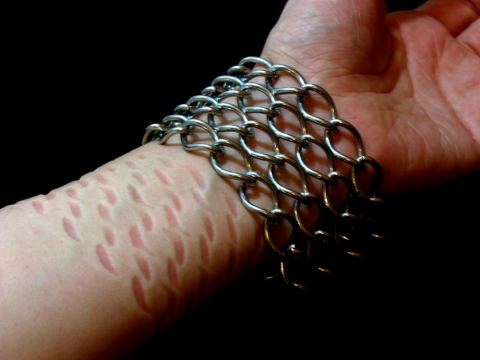





 As previously mentioned, the prescribed life of the monastery involved self-inflicted pain and suffering. The text Regula Magistri (Rule of the Master
As previously mentioned, the prescribed life of the monastery involved self-inflicted pain and suffering. The text Regula Magistri (Rule of the Master


 The co-founder of this group is Pacific School of Religion alum Rev. Tim Hamilton. Here is an excerpt from his bio page on the MCCLA website:
The co-founder of this group is Pacific School of Religion alum Rev. Tim Hamilton. Here is an excerpt from his bio page on the MCCLA website:

